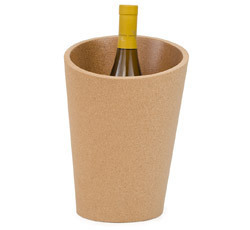
Cork stems from the bark of a cork oak. The main producer is Portugal, where cork oak forests play an important role in local eco-system. It is a natural, renewable material, where the tree stays intact when the cork is harvested. The cork is currently used for stoppers of wine bottles and all kinds of agglomerate applications
The method of materials based value creation for Cork as depicted:
‘Main material selection’ Cork was selected as a promising material for sustainable products
a “design intervention” was organised, where designers were asked to create products with maximum value, made from cork. The result was a group of 36 products of all kinds (chairs, baskets, tables, wine bottle coolers, etc, etc.)
After the design process, the eco-costs and the value were determined for each product and compared with an existing product with a similar function and quality.
Where possible, the product designs were improved in terms of eco-costs, under the condition that this didn’t result in a lower value.
Designs with higher eco-costs than the existing product were abandoned, so the end result of the project was a list of 29 products with higher value and lower eco-costs.
One of the examples; The original design was a cork wine bottle chiller in a shiny stainless steel plate which can be clamped to the table. The value was good, however, the eco-costs were too high because of the stainless steel (design 1). The first idea was to replace the stainless steel by wood, however, that ruined the value (design 2). The best solution was a high carbon with chromium plating (design 3): the value was excellent combined with reasonably low eco-costs.
FURTHER DEVELOPMENTS
A next PhD project has just been started on cork in the field of high tech applications. The project will be structured in a similar way. Further PhD projects are on bamboo, rattan and textile. A similar approach is followed to analyse product portfolios of companies.
A PhD in the field of housing 12 will be followed by a European project of the CEEC (The Council of European Construction Economists).
The main development of the EVR model itself is the application in Cradle to Cradle (C2C) design. The main issue is to apply LCA and to test C2C design strategies. A first design study of a “sustainable C2C bike” is in progress.

Comments by our Users
Be the first to write a comment for this item.